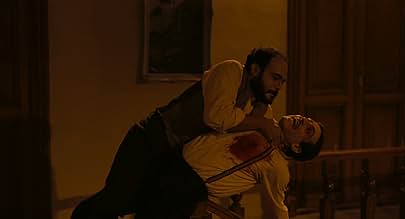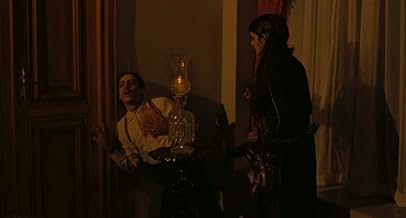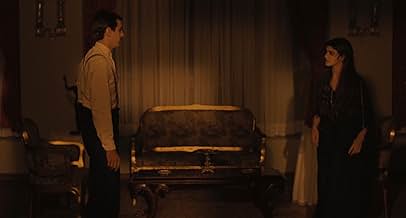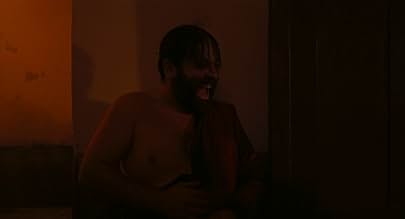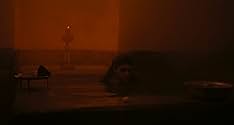IMDb-BEWERTUNG
7,3/10
2085
IHRE BEWERTUNG
Die erste Dame eines Adelshauses ist gestorben und nun gibt es Streit zwischen den Hinterbliebenen um ihr Erbe.Die erste Dame eines Adelshauses ist gestorben und nun gibt es Streit zwischen den Hinterbliebenen um ihr Erbe.Die erste Dame eines Adelshauses ist gestorben und nun gibt es Streit zwischen den Hinterbliebenen um ihr Erbe.
- Regie
- Drehbuch
- Hauptbesetzung
- Auszeichnungen
- 1 Nominierung insgesamt
Empfohlene Bewertungen
This movie looks good - I mean it really looks good. Cinematography combined with set design and the editing that was done. Costumes and gadgets work hand in hand together - the story plays sort of a second fiddle to it. It has some horror influences to it - nothing that will shock you too much of course.
More than rock solid, especially if you really are into appearances. Acting is good and for the time it was made and where it was made, the movie tries to push some boundaries story wise for sure ... the pacing is something you will either be on board with or not. Because watching trivial washing or other activities that are not really suspensful - but look good and do something for the characters, is something you have to dig - suspend your disbelief and just go with the slow flow.
More than rock solid, especially if you really are into appearances. Acting is good and for the time it was made and where it was made, the movie tries to push some boundaries story wise for sure ... the pacing is something you will either be on board with or not. Because watching trivial washing or other activities that are not really suspensful - but look good and do something for the characters, is something you have to dig - suspend your disbelief and just go with the slow flow.
It's extraordinary that this film was found in a junk yard in 2014, long after it was assumed to have been destroyed, and we're lucky it was, it's so gorgeous. It's a pre-Revolution film that plays like a Greek tragedy, complete with a chorus in the form of the washerwomen who help fill in the backstory of the people vying for the riches of a woman who's just died. There's her wheelchair-bound daughter (Fakhri Khorvash), her evil husband who only married her recently (Mohammad-Ali Keshavarz), the man's two nephews, and a handmaiden who's a bit of a wildcard in the deck (Shohreh Aghdashloo, in her debut film). Amidst a sumptuous mansion, tension simmers until violence breaks out and an eerie drama ensues.
Director Mohammad Reza Aslani gives us quite a visual feast in this film - the patterns, textures, and colors are all dazzling. Several times he takes his time on tight shots showing us details, like the laying out of a dinner spread, lighting a chandelier made of candles, or loading a gun. His long shots are beautifully composed, like in the house, or the girl in red dancing in the street to traditional music. Perhaps most of all, it's his use of light and shadow that is memorable, mirroring the dark recesses of the human soul on display. Adding considerably to the atmosphere is the discordant, mysterious soundtrack from composer Sheida Gharachedaghi.
The film was apparently an outrage not only because of its violence, but also because of a few homosexual bits sprinkled in. The washerwomen gossip that the man of the house "liked young boys" and that his dead wife not only knew about it, but "she used to watch them doing it and laugh her socks off." We also see erotic hand stroking and an embrace with a clear lesbian implication between the daughter and her handmaiden. Ironically, it seems these things are present not as positives, but to emphasize the depravity of these people, who live in affluence and greedily hustle after money, counter to the warning in the Qu'ran verse at the outset of the film.
The handmaiden is an intriguing character because she seems to be trying to cover every base, involved with her mistress, the younger of the two nephews, and another person who I won't name so as not to spoil things. Meanwhile the older nephew is hedging his bets too, at first trying to get the daughter to marry him, despite her cringing at his every gesture, and also by his involvement in a murder plot. It's a tangled web which leads to a scene down in the basement one night which is brilliant. This one is quite a find, and a must watch.
Director Mohammad Reza Aslani gives us quite a visual feast in this film - the patterns, textures, and colors are all dazzling. Several times he takes his time on tight shots showing us details, like the laying out of a dinner spread, lighting a chandelier made of candles, or loading a gun. His long shots are beautifully composed, like in the house, or the girl in red dancing in the street to traditional music. Perhaps most of all, it's his use of light and shadow that is memorable, mirroring the dark recesses of the human soul on display. Adding considerably to the atmosphere is the discordant, mysterious soundtrack from composer Sheida Gharachedaghi.
The film was apparently an outrage not only because of its violence, but also because of a few homosexual bits sprinkled in. The washerwomen gossip that the man of the house "liked young boys" and that his dead wife not only knew about it, but "she used to watch them doing it and laugh her socks off." We also see erotic hand stroking and an embrace with a clear lesbian implication between the daughter and her handmaiden. Ironically, it seems these things are present not as positives, but to emphasize the depravity of these people, who live in affluence and greedily hustle after money, counter to the warning in the Qu'ran verse at the outset of the film.
The handmaiden is an intriguing character because she seems to be trying to cover every base, involved with her mistress, the younger of the two nephews, and another person who I won't name so as not to spoil things. Meanwhile the older nephew is hedging his bets too, at first trying to get the daughter to marry him, despite her cringing at his every gesture, and also by his involvement in a murder plot. It's a tangled web which leads to a scene down in the basement one night which is brilliant. This one is quite a find, and a must watch.
"Paying more attention to form than content, Aslani's expertise as a dramaturge is also humbled by his coordination of atmosphere and suspense, summoning a creepily ethnic, swelling percussive score by Sheyda Gharachedaghi, CHESS OF THE WIND's climatic confrontation looks like an out-and-out horror, the paraplegic daughter gruelingly and sinuously crawls about under the dim sepia light, you can barely make out her expressions and features, she morphs into a startled feral creature, operating with the primal instinct for self-preservation, to face the unseen threat with a final showdown. Eventually, the rushed ending leaves a bathetic aftertaste and Aghdashloo's expressiveness is left largely untapped, but CHESS OF THE WIND is such a rara avis in its own terms, indefinable, claustrophobic, conforming to an unrealistic tenet of cause and effect, that you ought to hand it to Aslani and his team for the muscular and idiosyncratic implementation of their own transgressive ideation and craft."
-
-
Beautiful images and lighting (with no electricity) of Teheran in the Twenties but the final crane shots reveal a modern day Teheran skyline with multistoried buildings and air-conditioning vents (a nod perhaps to Geza von Redvanyi's 1965 film "Uncle Tom's Cabin"). Two realities separated by time. The simplistic tale of greed for pelf and power is interspersed with chorus elements of Greek plays (here washerwomen discussing the lives of rich inhabitants of the mansion in the background.)
A lot of films from the Middle East have had a history of being banned often. There are many examples of lost movies which went largely unseen as few titles have maintained a cult status without proper distribution. Here we have a forgotten masterpiece of Iran's pre-revolution New Wave which belongs to the list of lost and found title. Director Mohammad Reza Aslani's Chess of the Wind/The Chess Game of the Wind (Shatranj-e Baad) was banned by the Ayatollah Khomeini regime in 1979 and it ended up on the shelf in an antique shop until its discovery in 2015. I don't want to go in any further about the rediscovery and restoration process. I suggest you to look it up as it is a very interesting read. Same time, i really want to thank Shirin Neshati for introducing this film. I want to appreciate and thank Martin Scorsese's World Cinema Project and Cineteca di Bologna for restoring this neglected masterpiece.
Coming to the story, it takes place during the reign of the Qajar dynasty, with the passing of a rich matriarch the battle for inheritance begins between the members of the family. The story unfolds like a arthouse drama with full of captious characters as the moral dimension is constantly changing in the gothic mansion to inherit the wealth. The main characters: Aghdas, a wheelchair-bound disabled daughter of the deceased. She is taken care by a young maid servant (Shohreh Aghdashloo) who devotes herself to cater to all the needs and wants of Aghdas. In later part of the film, we see both of them sympathize with each other and it hints that their relationship becomes intimate. The sequence is brilliantly shot, with amorous flush of hand gestures. It is not sexual or explicit but sensuous at times accentuated by the alluring score. We also have the evil stepfather Hadji and his nephews in the race for the "suitors" of the fortune. With arrival of few more characters as the the divide widens, triggering the gears of greed which leads to an amazing climax that will cement this film as a genre-hopping masterpiece. This family chronicle does not function as a typical story would. Rather, the structure is different as the director infuses every frame with paranoia, even the set pieces, antique furniture's in the mansion feel like its haunted. A hypnotic score by Sheida Gharachedaghi only adds to the film's sensory layers, by turns dark and discordant. I loved the dance sequence accompanied by a young girl wearing a red traditional dress and you know Kate Bush's Wuthering Heights vibes are strong. Even the climax, it looks mad in the restored version. I Immediately thought of Anna von Hausswolff's album cover for Dead Magic.
I know the reviews online have praised this as a tribute to Sergei Parajanov, Luchino Visconti, Luigi Bazzoni and Henri-Georges Clouzot. But for me this is a mix between Juraj Herz's Morgiana (1972) and Sergio Martino's Your Vice Is a Locked Room and Only I Have the Key (1972) with a strong Messiah of Evil (1973), Josep Losey's The Servant (1963) and Giallo influence. I recommend this to everyone to watch this atleast once, the restored version is an experience not to be missed. Although it will fly over many people's heads as it is really a test of patience, but it's worth it in the end.
Coming to the story, it takes place during the reign of the Qajar dynasty, with the passing of a rich matriarch the battle for inheritance begins between the members of the family. The story unfolds like a arthouse drama with full of captious characters as the moral dimension is constantly changing in the gothic mansion to inherit the wealth. The main characters: Aghdas, a wheelchair-bound disabled daughter of the deceased. She is taken care by a young maid servant (Shohreh Aghdashloo) who devotes herself to cater to all the needs and wants of Aghdas. In later part of the film, we see both of them sympathize with each other and it hints that their relationship becomes intimate. The sequence is brilliantly shot, with amorous flush of hand gestures. It is not sexual or explicit but sensuous at times accentuated by the alluring score. We also have the evil stepfather Hadji and his nephews in the race for the "suitors" of the fortune. With arrival of few more characters as the the divide widens, triggering the gears of greed which leads to an amazing climax that will cement this film as a genre-hopping masterpiece. This family chronicle does not function as a typical story would. Rather, the structure is different as the director infuses every frame with paranoia, even the set pieces, antique furniture's in the mansion feel like its haunted. A hypnotic score by Sheida Gharachedaghi only adds to the film's sensory layers, by turns dark and discordant. I loved the dance sequence accompanied by a young girl wearing a red traditional dress and you know Kate Bush's Wuthering Heights vibes are strong. Even the climax, it looks mad in the restored version. I Immediately thought of Anna von Hausswolff's album cover for Dead Magic.
I know the reviews online have praised this as a tribute to Sergei Parajanov, Luchino Visconti, Luigi Bazzoni and Henri-Georges Clouzot. But for me this is a mix between Juraj Herz's Morgiana (1972) and Sergio Martino's Your Vice Is a Locked Room and Only I Have the Key (1972) with a strong Messiah of Evil (1973), Josep Losey's The Servant (1963) and Giallo influence. I recommend this to everyone to watch this atleast once, the restored version is an experience not to be missed. Although it will fly over many people's heads as it is really a test of patience, but it's worth it in the end.
Wusstest du schon
- WissenswertesThe film was banned in Iran in 1979 by the then new regime and presumed lost, only to be found years later by the director's children in a junk shop. It has been painstakingly restored and was shown at the BFI London film festival in 2020.
- VerbindungenFeatured in CBS News Sunday Morning: Folge #45.25 (2023)
Top-Auswahl
Melde dich zum Bewerten an und greife auf die Watchlist für personalisierte Empfehlungen zu.
- How long is Chess of the Wind?Powered by Alexa
Details
- Erscheinungsdatum
- Herkunftsland
- Offizieller Standort
- Sprache
- Auch bekannt als
- Chess of the Wind
- Drehorte
- Produktionsfirma
- Weitere beteiligte Unternehmen bei IMDbPro anzeigen
Zu dieser Seite beitragen
Bearbeitung vorschlagen oder fehlenden Inhalt hinzufügen


